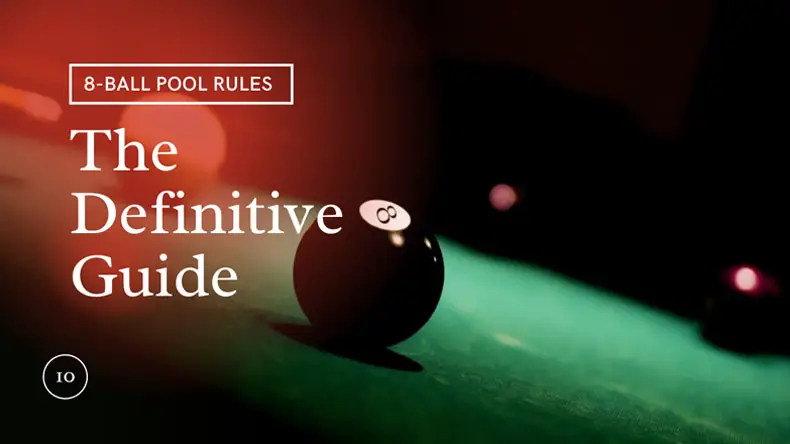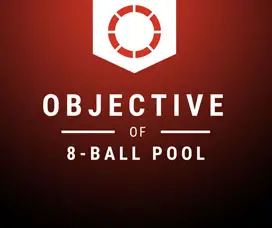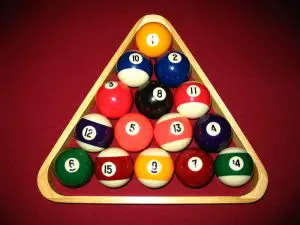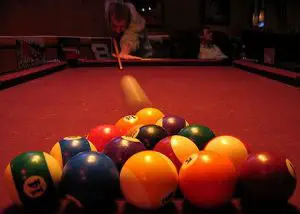8-ball also known as solids and stripes, eight-ball is a pool billiards which is played on a table having six pockets, while sixteen billiard balls are used. These sixteen balls include a cue ball, and fifteen object balls.
The game of billiard became popular in the early 1900s, in the USA.
By 1925, it had become so popular that Brunswick-Balke-Collender Company introduced the purpose made ball sets including seven red, seven yellow, one black ball and one cue ball which later became standard in professional billiards.

The game has become quite popular all over the world, now we have so many variations of this game available that one can be easily confused by them.
Because they are mostly regional, it becomes more tricky to learn each of them. However, in this article, we’ll talk about each in detail.
First, we’ll discuss the common rules of the eight ball pool, that are part of more or less every variation. And then we’ll discuss each variation separately.

The objective of all variations is the same, player pocketing the 8th ball after pocketing his group wins the game.
This is true for international Pool, APA Pool, WPA, English eight ball pool or BCA eight ball Pool.

Another common rule in these variations is racking of the ball.
To start the game, balls are racked in a triangle fashion at the foot of the table. The 8-ball goes in the center of the triangle, the first ball on the footspot, a stripe ball in the corner, while a solid ball is in the other corner.
This rule is common in WPA, BCA, APA, English, and International 8-ball Pool or professional 8-ball pool rules.
Just to let you know, in case you are unaware of this fact, balls with number (1-7) have a different color, they are called stripe, while balls with number ( 9-15) are of the same colours, they are called solids.

For a shot to be legal, the player must either pocket a ball or drive at least four numbered balls to the rail. If he fails to do so, the opponent gets the ball.
Break shot is part of every variation of Pool because this is how a game is started. No matter what variation you are playing, WPA, BCA, or any other, a break shot exists in every game.
The other player gets two options, either accept the table in position and start shooting. Or have the balls to be reracked and shoot the opening break himself. And, just in case you shot the ball off the table during the opening break, you forfeit your turn.
This rule is also true for every variation, however in casual games this can often lead to game loss.
This is another common rule in many Pool variations.
If a player intentionally or mistakenly scratches on a legal break shot or hits the ball out of the table, the balls will be reracked and the opposite player will take a shot. And, if he has pocketed an object ball during the scratch, the object ball remains pocketed.
This rule is common in international, BCA, APA and WPA rules.
In case, you want to learn more about scratch in pool games, read our detailed article here.
It’s quite an interesting rule because you have to call the shot before you hit the ball. And you have to say it loud so your opponent can hear it.
However, According to this rule, it is OK if obvious balls and pockets are not indicated. Moreover, the opponent has the right to ask if he’s unsure about it. When you are calling a shot, it is not necessary to indicate details like rails, doubles, cannons, etc.
But just to let you know, opening break is not a called shot.
Except for APA, you have to call shot in WPA, BCA, and international 8-ball pool.
If you pocket the ball in the wrong pocket, it is considered a foul. And the other player gets the opportunity to take the cue ball in hand and place it anywhere on the table. This is a common practice in WPA, BCA, and in standard pool rules.
Like all billiards games, there are some rules regarding playing when you are standing on the table. In case you don’t follow them, you pay the price for them in the form of fouls and illegal shots.
Jumping while taking a shot or scooping the cue ball is considered a foul in all games. If you cause this foul, your opponent gets the cue ball regardless of the fact where it is on the table.
Using hands on the ball in order to stop it is also considered a foul.
For instance, you are playing and intentionally or unintentionally you hit the ball shot by another player and it stops moving. In this case, you’ll have to bear the foul and your opponent will have the freedom to put the cue ball anywhere on the table and have another go.
You must let the other ball hit by your opponent to stop before you take your shot. If the other ball is still moving and you have taken your aim at your cue ball, it will be considered a foul and your opponent will get the freedom to place the cue ball anywhere on the table.
Combination shots are legal in pool, given that you don’t contact the 8th-ball first in order to pocket the object ball.
For instance, if your cue ball contacts the 8th-ball first and then contacts with the object ball, it will be considered illegal and the other person will get his turn. Or, in case your cue ball makes contact with an object ball first, then with the 8th ball, it will be considered legal.
You can’t strike the 8th ball before finishing all object balls.
These foul are part of all variations, as they indicate clear cheating or unfair advantage over your opponent.
You either choose stripes or solids to pocket. For instance, the table becomes open after the first shot. After that, whoever pockets a particular category of ball, he will only pocket those balls or 8-ball in the game. If you have chosen stripes, you’ll pocket stripes throughout the game. Or vice versa.
This rule is true for BCA and other common variations except for APA.
If you mistakenly pocket the wrong ball (in case your object ball is stripe and you hit the solid), the ball will remain pocketed and your opponent will have one less ball to pocket because of your mistake.
Likewise, if you have pocketed the eight ball before pocketing the object ball, it comes back and your opponent gets the chance to either re rack or place the eight-ball on footspot.
And to win the game, you keep pocketing your chosen object balls. Once you have pocketed all the object balls, you can then go for the 8th ball. The first person to do so wins the match. Or, in case, you pocket the ball in the wrong pocket, then you forfeit the game and the other person will win it.
This is true for all common variations like WPA, BCA, APA, etc.
Likewise, there are certain conditions in the pool in which you lose the game if you pocket the wrong ball.
This rule too is quite common in popular pool variations like WPA and BCA.
To summarize all the fouls, have a look at the common fouls listed below:
These are common fouls which you will find in all variations of pool.
Foul Penalty
Likewise, penalties of these fouls are the same in different variations like WPA, BCA, or, in other words, they are part of international 8-ball pool rules.
In case of a foul penalty, your opposing player gets the ball in hand and he has the freedom to place it anywhere on the table (except for behind the head string except on opening break).
With the cue ball in hand, a player can even use his cue to position the ball on the table so that he can take a perfect aim.
However, it is to keep in mind that if you mistakenly stroke the ball in forward motion while placing it, it will be considered as a foul.
This foul penalty is almost the same in all variations, except if you are playing in a circle where formal rules are moulded.
Now we’ll talk a bit about the rules that vary from one variation to another, so just in case you get a chance to play pool in a different region, you are well-versed with the rules to execute your game in a legal way.
We’ll start from APA (American Poolplayers Association) rules.
APA 8-ball rules has some different rules from the traditional or I should say international pool rules Let’s have a brief look at them.
Likewise, there are some rules which are different in BCA (Billiards Congress of America) from what we see in normal pool versions.
Another interesting variation of pool is VNEA 8-ball pool (Valley National 8-ball League Association).
The most notable difference in the English eight ball pool and other variations is of time.
And now, we’ll put some light on league rules, basically it will be a comparison between APA VS BCA. American Poolplayers Association and the Billiard Congress of America are two of America’s biggest leagues with slight differences in rules. Here, we’ll talk a bit about those differences.
| Area of Comparison | BCA | APA |
|---|---|---|
| After The Break | The table remains open after the break and you can choose whichever category of ball you want to by pocketing it | You can only choose the ball by hitting it in the break, and this ball will remain your object ball for rest of the match |
| Call Shot | You have to call every shot | You don’t need to call shots |
| 8th ball Call Shot | Likewise, you have to call 8th-ball shot | You don’t have to call 8th-ball shot |
| Scratching On 8th Ball | You don’t lose if you scratch on the 8th-ball. Only your opponent will get the cue ball in hand to place it anywhere on table | You lost if you scratch on the 8th-ball |
The game of eight ball pool is so exciting that people have moulded it differently. That’s why we have so many different versions of eight ball pool now that it gets difficult to differentiate. Based on the above mentioned facts, one can say APA is a little more difficult than BCA because of rigid rules.
The game of eight ball pool is quite common in bars, however, the rules in them are not the same as we see them in leagues. I’m going to share a few common rules applied on bars, but it’s not necessary that they’d be the same in yours.
Is the 8-ball neutral?
Yes, the 8-ball is also called neutral because both solid and stripes are taken by the players. One goes after the stripes while the other against the solids. Since there is only one 8-ball which both can hit after finishing object balls, it is also called neutral.
Can you use the 8-ball combo in the pool?
No, in order for a shot to be legal, it must hit the object ball (of that player) first before hitting the 8th ball. In short, hitting the 8th ball directly (before it’s the only one left) is illegal.
What happens if you sink both a solid and stripe in the break in 8-ball? Do you play for whatever sinks first?
Actually, if you are playing in a bar, there might be different rules for this bizarre situation. However, in general rules, if both solids and stripes are pocketed in the same shot, the table remains open until the next ball is pocket from either category.
In 8-ball, if you hit your object ball and your opponent’s object ball is also sinked with it. Do you get another shot?
It depends on which ball your cue ball hit first. For instance, you hit a ball and your cue ball hits your object ball first, then both (your ball and your opponent’s object ball) sink, you’ll continue to shoot. However, if your cue ball hits your opponent’s object ball first, you scratch.
On your last shot, you simultaneously called and hit your last solid and eight ball, sank both where you wanted them, with solid dropping first, eight walking like you wanted, who won the game?
Unfortunately, you lost. Why? Because you are supposed to pocket the 8-ball in a separate turn, after finishing all your object balls. However, in this case, you pocketed the two in the same turn, therefore you lost.
So, if we sum up this guide on different variations of eight-ball pool, we can say that eight-ball itself is a big game. You might not be able to learn every variation by simply reading them. If you want to learn each of them, you must apply the rule from each while playing to get accustomed to it. Or, you should focus only on those variations which are more common in your region.
Hello Everyone! I am Maryam, the reason behind creating this website is to help people with the detailed information and reviews about sports products
10sorts.com is a participant in the Amazon Services LLC Associates Program, and we get a commission on purchases made through our links.

